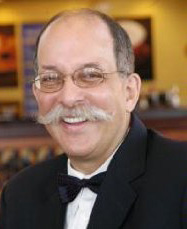The Modern Butlers’ Journal volume 8, issue 1
International Institute of Modern Butlers
Message from the Chairman
 Welcome to 2012, a year that promises to be anything but boring with high economic, social, and political stakes. It is the year in which quite a few people are convinced none of us will see it through to the end, as they expect the world to end on 21 December. If you find this kind of talk disconcerting, then please rest assured that this prediction is one of eleven different versions of how it will all end at various anticipated times over the next 30 years, and that it joins a long list of 465 predictions for the end of the world of which there is a written record over the last 4,800 years ago. What seems to escape each person making and buying into such predictions, is that not a single one has come true. Our view is that 2012 will go to those who keep their eye on the ball, remaining in the moment and creating and having fun along the way.
Welcome to 2012, a year that promises to be anything but boring with high economic, social, and political stakes. It is the year in which quite a few people are convinced none of us will see it through to the end, as they expect the world to end on 21 December. If you find this kind of talk disconcerting, then please rest assured that this prediction is one of eleven different versions of how it will all end at various anticipated times over the next 30 years, and that it joins a long list of 465 predictions for the end of the world of which there is a written record over the last 4,800 years ago. What seems to escape each person making and buying into such predictions, is that not a single one has come true. Our view is that 2012 will go to those who keep their eye on the ball, remaining in the moment and creating and having fun along the way.See you in 2013, flourishing and prospering in your line of work!
Butlers in the Media
Two interesting articles on butlers last month:
2) English Butlers Wanted For Emerging Super-Rich
and one rather hopeless article from Huffington Post, which really needs to sharpen its reportage. Finally, a list of the world’s most expensive hotels for consideration by your employer for when he or she needs to travel. It is far from comprehensive, as three hotels I have trained at this year alone have suites that would rank them as #2, #3, and #4, yet they do not make the list at all. I would recommend Fischer Travel as the best source for the top suites around the world. (Note: this article is written in German).
 Minimizing Use of Silver Polish
Minimizing Use of Silver Polish
by Jeffrey Herman of Herman Silver Restoration & Conservation
Wash silver objects periodically (in order to avoid arduous polishing sessions to remove accumulated tarnish) with warm water and a phosphate-free detergent such as Dawn (not lemon-scented), and dry immediately. Do not immerse any object that has hollow sections or wooden parts  such as handles. If tarnish does build up, remove it as soon as possible for two reasons: (1) it is much easier to remove tarnish in its early stages of formation; and (2) your silver will show less wear, as it will be exposed to less abrasion. Most of us are familiar with that light brown – and eventually black – color that forms on silver as it tarnishes. To catch tarnish in its very early stages, hold the silver object against a piece of white paper (glossy paper preferred). If tarnish has started to form, you will see a very light yellowish tint in the silver. Try removing this light tarnish with either Windex Multi-Surface Vinegar or Purell Original Formula hand sanitizer. Use a cotton towel or cotton ball and rotate the material regularly to expose unused surfaces – elements in the tarnish itself can be very abrasive. If tarnish remains after using the above products, a silver polish will be required (see my Silver Care Guide for pointers). As always, feel free to email me should you have any questions (jeff@hermansilver.com).
such as handles. If tarnish does build up, remove it as soon as possible for two reasons: (1) it is much easier to remove tarnish in its early stages of formation; and (2) your silver will show less wear, as it will be exposed to less abrasion. Most of us are familiar with that light brown – and eventually black – color that forms on silver as it tarnishes. To catch tarnish in its very early stages, hold the silver object against a piece of white paper (glossy paper preferred). If tarnish has started to form, you will see a very light yellowish tint in the silver. Try removing this light tarnish with either Windex Multi-Surface Vinegar or Purell Original Formula hand sanitizer. Use a cotton towel or cotton ball and rotate the material regularly to expose unused surfaces – elements in the tarnish itself can be very abrasive. If tarnish remains after using the above products, a silver polish will be required (see my Silver Care Guide for pointers). As always, feel free to email me should you have any questions (jeff@hermansilver.com).
Graduation
 As part of a multi-month roll-out of improved butlerservice aboard the Norwegian Cruise lines thatis designed to set a new standard for butler service in the cruise line industry, enthusiastic butler trainers from several vessels completed their Train the Trainerscourse in December and will be heading back to their vessels to institute the next phase of the program.
As part of a multi-month roll-out of improved butlerservice aboard the Norwegian Cruise lines thatis designed to set a new standard for butler service in the cruise line industry, enthusiastic butler trainers from several vessels completed their Train the Trainerscourse in December and will be heading back to their vessels to institute the next phase of the program.
Let’s talk about wine
by Amer Vargas
In our last article, we covered the nature of wine, where it comes from, and the basic steps of wine production. In this article, we will focus on white wines.
First steps Harvesting for white wines is commonly accomplished at night to take advantage of low temperatures and to preserve all the properties of the grapes. The first step thereafter is de-stemming, separating the fruit from the tannin-rich stalks and then cooling the grapes to 52 oF/11 oC; after which the fruit is transferred to a press where the juice is separated from the tannic and color-giving skin and bitter-oiled pips, thereby producing grape juice or must.
From must to wine This freshly pressed must looks like peach juice, a thick and murky drink with no alcohol content that is a far cry from the delicious, transparent libation aimed for. It is transferred to large tanks where it is kept at a steady temperature of 59-61oF/15-16oC and allowed to rest so any solids can sink to the bottom of the tank. After one or two days, the clean must, now as clear as wine and sweet, is transferred to another tank made of oak or stainless steel (or other inert material that will not add tastes to the wine).
It is at this stage that fermentation takes place as the sugars in the must are converted into alcohol. Vintners are obliged to add a yeast culture to augment the fermentation process, as little yeast is present in clean must when it is separated rapidly from the skins and pips.
The yeast culture A yeast culture is a mix of water and dried yeasts. In order for yeasts to hydrate and ferment the wine-to-be, they need to be mixed with right amount of water at 100-104oF/38-40oC. Within a few minutes of the mix being created and stirred, bubbles start to appear on the surface, indicating the yeasts are active. Clean must is then added little by little to the culture to lower its temperature to that of the clean must in the tank. When this temperature is achieved, the yeast culture is added to the tank; the fermentation starts in about three days and lasts 7-10 days, sometimes even longer, the wine having the appearance of water coming to a boil. During this period, density and temperature are measured at least twice a day to ensure the yeasts are performing properly, with adjustments being made in nutrients or oxygenization if they aren’t. After the fermentation is complete, a secondary one, malolactic fermentation, may be carried out to reduce the acidity of a wine (by transforming the tart-tasting malic acid that is present in the must into C02and a softer lactic acid). This secondary fermentation is common in red wines more than whites: while Chardonnays, Pinot Blancs, and Pinot Gris that are to be laid aside for aging are taken through the malolactic fermentation, wines with a greater acidity, such as Rieslings or Gewürztraminers, are not put through a secondary fermentation so as to maintain their freshness.
Next in the sequence is the clarification of the drink to remove byproducts of the fermentations, such as yeasts, bacteria, or proteins that could continue to change the wine. Young whites can be taken to these final filtering steps straight away, but vintners will age others a few months or years to add texture, aromas, and complexity to the wine in oak or stainless steel tanks, always under cold and steady conditions. The wine is filtered through such as diatomaceous earth to remove any remaining solid particles before storing the wine in a cold tank at 25oF/-4oC.
Cold stabilization is designed to remove the elevated levels of potassium bitartrate crystals created during the fermentation process.
After this, the wine undergoes polish filtering, a second filtration with thinner soils that leave a bright and clean wine ready to be bottled.
The Household Manager – Who am I?
I must be a diplomat, a democrat, an autocrat, an acrobat, and doormat. I must have the ability to entertain Prime Ministers, Princes of Industries, Pickpockets, Gamblers, Bookmakers, Pirates, Philanthropists, and Prudes. I must be on both sides of the political fence, and be able to jump that fence.
I must be or have been, a footballer, golfer, bowler, tennis player, cricketer, dart player, sailor, pigeon fancier, motor racer, or linguist, and have a good knowledge of any other sports involving dice, cards, horses, and pool cues. As I sometimes have to settle arguments and squabbles, I must be a qualified boxer, wrestler, weight lifter, sprinter, and peacemaker.
I must always look immaculate when drinking with ladies and gentlemen–as well as with bankers, swankers, theatricals, commercial travelers, and company representatives, even though I may have just made peace between any two, six or more of the aforementioned patrons.
To be successful I must keep the bar full, the house full, the storeroom full, the wine cellar full, the employer full, and not become full myself; I must have staff who are clean, honest, quick workers, quick thinkers, non drinkers, mathematicians, technicians, and at all times on the boss’s side and the guest’s side, but always outside the bar.
To sum up: I must be outside, inside, offside, sanctified, crucified, cross eyed: and if I am not the strong and silent type, there is always suicide.
I am The Butler and Household Manager and Proud to Be So.
By Olivier De Boynes, as submitted by Wayne Fitzharris


